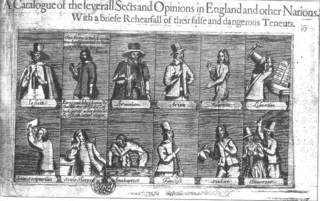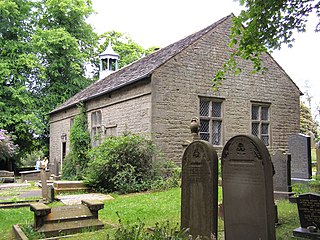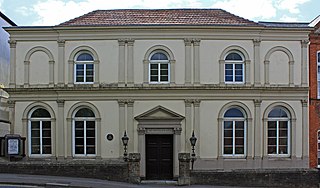
Aberdare is a town in the Cynon Valley area of Rhondda Cynon Taf, Wales, at the confluence of the Rivers Dare (Dâr) and Cynon. Aberdare has a population of 39,550. Aberdare is 4 miles (6 km) south-west of Merthyr Tydfil, 20 miles (32 km) north-west of Cardiff and 22 miles (35 km) east-north-east of Swansea. During the 19th century it became a thriving industrial settlement, which was also notable for the vitality of its cultural life and as an important publishing centre.
Congregationalist polity, or congregational polity, often known as congregationalism, is a system of ecclesiastical polity in which every local church (congregation) is independent, ecclesiastically sovereign, or "autonomous". Its first articulation in writing is the Cambridge Platform of 1648 in New England.

In English church history, Nonconformists were Protestant Christians who did not "conform" to the governance and usages of the state church, the Church of England.
The General Assembly of Unitarian and Free Christian Churches is the umbrella organisation for Unitarian, Free Christians, and other liberal religious congregations in the United Kingdom and Ireland. It was formed in 1928, with denominational roots going back to the Great Ejection of 1662. Its headquarters is Essex Hall in central London, on the site of the first avowedly Unitarian chapel in England, set up in 1774.

English Dissenters or English Separatists were Protestants who separated from the Church of England in the 17th and 18th centuries.

Toxteth Unitarian Chapel is in Park Road, Dingle, Liverpool, Merseyside, England. Since the 1830s it has been known as The Ancient Chapel of Toxteth. It is recorded in the National Heritage List for England as a designated Grade I listed building. and continues to be in use as a Unitarian chapel. It is a member of the General Assembly of Unitarian and Free Christian Churches, the umbrella organisation for British Unitarians.

Nottage is a small village part of Porthcawl in Bridgend County Borough, Wales. It is also the name of an electoral ward to the town and county councils.

The Upper Brook Street Chapel, also known as the Islamic Academy, the Unitarian Chapel and the Welsh Baptist Chapel, is a former chapel with an attached Sunday School on the east side of Upper Brook Street, Chorlton-on-Medlock, Greater Manchester, England. It is said to be the first neogothic Nonconformist chapel, having been constructed for the British Unitarians between 1837 and 1839, at the very beginning of the reign of Queen Victoria. It was designed by Sir Charles Barry, later architect of the Palace of Westminster.

Dissenting Gothic is an architectural style associated with English Dissenters - Protestants not affiliated with the Church of England. It is a distinctive style in its own right within Gothic Revival architecture that emerged primarily in Britain, its colonies and North America, during the 19th century.

Rivington Unitarian Chapel is an active place of Unitarian worship in Rivington, Lancashire, England. It was founded in 1703, although its congregation dates to 1667. It is designated as a Grade II* listed building with some restoration in 1990, and hs ongoing preservation.

Southover General Baptist Chapel is a former Baptist place of worship in the ancient village of Southover, now part of the town and district of Lewes, one of six local government districts in the English county of East Sussex. Founded in 1741 as the first Baptist place of worship in the area, it attracted a congregation of General Baptists whose theological views gradually moved towards Unitarianism. This led to their union with the members of the nearby Westgate Chapel, after which the flint and brick building housed other congregations and secular groups before its conversion to a house. The building is protected as a Grade II by English Heritage.

Billingshurst Unitarian Chapel is a place of worship in Billingshurst in the English county of West Sussex. The cottage-like building was erected in 1754 for General Baptists, hence its original name of the Billingshurst General Baptist Chapel, but the congregation moved towards Unitarian beliefs in the 19th century, and still maintain these. It is a member of General Assembly of Unitarian and Free Christian Churches, the umbrella body for British Unitarians.

Horsham Unitarian Church is a Unitarian chapel in Horsham in the English county of West Sussex. It was founded in 1719 to serve the large Baptist population of the ancient market town of Horsham—home of radical preacher Matthew Caffyn—and the surrounding area. The chapel's congregation moved towards Unitarian beliefs in the 19th century, but the simple brick building continued to serve worshippers drawn from a wide area of Sussex. It is one of several places of worship which continue to represent Horsham's centuries-old tradition of Protestant Nonconformism, and is the town's second oldest surviving religious building—only St Mary's, the parish church, predates it. English Heritage has listed the chapel at Grade II for its architectural and historical importance.


Bethel Baptist Chapel is a Strict Baptist place of worship in the village of Wivelsfield in East Sussex, England. The cause was founded in 1763 by members of a chapel at nearby Ditchling; Henry Booker and other worshippers seceded and began to meet at Wivelsfield after hearing a sermon by George Whitefield. Although some members of the new church soon returned to the Ditchling congregation, the cause thrived under Booker's leadership, and the present chapel—a building of "quiet and unassuming elegance" set in its own graveyard—was erected in 1780. It has served the Strict Baptist community continuously since then, and members founded other chapels elsewhere in Sussex during the 18th and 19th centuries. The chapel is a Grade II Listed building.

Ditchling Unitarian Chapel is a Unitarian chapel in Ditchling, a village in the English county of East Sussex. A congregation of General Baptists began to meet in the 17th century in the village, which was a local centre for Protestant Nonconformist worship, and by the time the present simple Vernacular-style chapel was constructed in 1740 a large proportion of the population held Baptist beliefs. Along with other General Baptist chapels in Sussex, the congregation moved towards Unitarian views in the mid-18th century; this caused a schism which resulted in a new chapel being formed at nearby Wivelsfield. The character of the Ditchling chapel was wholly Unitarian by 1800, and it has continued under various names since then. People associated with the chapel include William Hale White, Henry Acton, Adrian Boult—who was married there—and G. K. Chesterton. The chapel is set back from Ditchling's main street and has an adjoining house and graveyard, all of which contribute to the character of the conservation area which covers the centre of Ditchling village. English Heritage has listed the chapel at Grade II for its architectural and historical importance.
Nonconformity was a major religious movement in Wales from the 18th to the 20th centuries. The Welsh Methodist revival of the 18th century was one of the most significant religious and social movements in the modern history of Wales. The revival began within the Church of England in Wales, partly as a reaction to the neglect generally felt in Wales at the hands of absentee bishops and clergy. For two generations from the 1730s onwards the main Methodist leaders such as Howell Harris, Daniel Rowland and William Williams Pantycelyn remained within the Church of England, but the Welsh revival differed from the Methodist revival in England in that its theology was Calvinist rather than Arminian. Methodists in Wales gradually built up their own networks, structures, and meeting houses, which led, at the instigation of Thomas Charles, to the secession of 1811 and the formal establishment of the Calvinistic Methodist Presbyterian Church of Wales in 1823.

Taunton Unitarian Chapel is on Mary Street, Taunton, Somerset, England. It was built in the early 18th century as a Baptist chapel, but later adopted Unitarianism. The exterior was extensively renovated in the 19th century in an Italianate style. The chapel has been designated as a Grade II* listed building.

Meadrow Unitarian Chapel is a Unitarian chapel in the Farncombe area of Godalming, Surrey, England. It is part of the London District and South Eastern Provincial Assembly of Unitarian and Free Christian Churches, one of 16 districts within the General Assembly of Unitarian and Free Christian Churches, the umbrella organisation for British Unitarians.

Hastings Unitarian Church, also known as Hastings Unitarian and Free Christian Church, is a place of worship for Unitarians in the town and borough of Hastings, one of six local government districts in the English county of East Sussex. It has been in continuous use since it was built in 1868, having been founded the previous year by prominent Unitarian John Bowring for a congregation which had met in hired premises since 1858. The church, designed by George Beck, is Neoclassical in style and has an 18th-century organ.


















